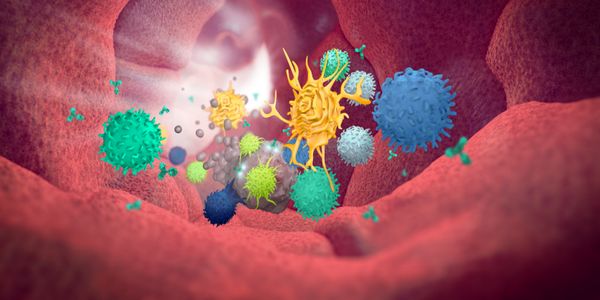Human development
Human development describes the stages of human life. Human development consists of 5 stages. Infancy (up to one year), toddler (age 1 - 5), childhood (age 3 - 11), adolescence (age 12 - 18), and adulthood. The study of human development aims to understand how people grow, develop, and change throughout their life.
-
SEP 17, 2020 | 12:15 PMAbnormal cellular metabolism is a hallmark of many diseases, yet there is an absence of quantitative methods to dynamically image metabolism with cellular-level resolution. Optical metabolic...SEP 17, 2020 | 9:00 AMIn recent months, we have seen a large part of the global scientific community shift to infectious disease research. In response, researchers are exploring safer and easier methods to handle...SEP 17, 2020 | 8:00 AMDATE: September 17, 2020 TIME: 8:00am PT CRISPR-Cas9 has tremendous potential as a therapeutic tool for treating human diseases. However, prolonged expression of the nuclease and gRNA from v...SEP 16, 2020 | 1:30 PMThe recent development of highly multiplexed methods for imaging tissues from patients and mouse models promises to fundamentally advance research in tissue biology and disease. These new te...SEP 16, 2020 | 12:15 PMImage-based high-content screening (HCS) involving cancer cell lines grown in conventional two-dimensional (2D) cell culture, has provided a cornerstone assay for searching new agents to tre...SEP 16, 2020 | 9:00 AMDate: September 16, 2020 Time: 9:00am PTD, 12:00pm EDT Harnessing the power of the host immune system to treat diseases has been transformational in patient care. Physiologically relevant ce...SEP 16, 2020 | 11:00 AMThis talk will peek under the hood to show how we combine deep learning models with biology lab automation at Recursion Pharmaceuticals. Every week, we generate millions of microscopy images...SEP 10, 2020 | 12:00 PMIn this webinar, we will present QIAGEN CLC Genomics Workbench and its utility for bacterial isolate identification, strain discrimination using core genome multi-locus typing (cgMLST) and d...Speaker: Jonathan Jacobs, PhDSEP 10, 2020 | 11:00 AMLearning Objectives: 1. Understand the challenges of extracting DNA from human samples for microbiome analysis, and learn about the best technologies for accomplishing this 2. Learn about pr...Speaker: Dominic O'Neil, MS, MBASEP 10, 2020 | 9:00 AMCongenital CMV is the most frequent infectious cause of neonatal malformation in developed nations. It is more prevalent than other neonatal conditions such as spina bifida and Down syndrome...Speaker: William Rawlinson, PhDSEP 10, 2020 | 7:30 AMThe selective pressure placed on the resident microbiota by local changes in the host environment – DNA damage, chronic inflammation, metabolic shifts, barrier damage, reduced immunosu...Speaker: K. Leigh Greathouse, PhD, MPH, MS, RDPresented at: Microbiology Week Virtual Event Series 2020
SEP 10, 2020 | 6:00 AMCoronavirus disease 2019 (COVID-19), caused by SARS-CoV-2, is spreading rapidly across the world and was announced as a “global pandemic” by the World Health Organization (WHO) o...Speaker: Quan Wang, PhD , Renhong Yan, PhDSEP 10, 2020 | 12:00 AMViruses are the causative agents of approximately 12% of human cancers. The most recently discovered herpesvirus, Kaposi’s sarcoma herpesvirus (KSHV) is known to cause three human canc...SEP 10, 2020 | 12:00 AMThe transfer of antimicrobial resistance genes (ARG) to pathogenic microbes is a major concern in modern medicine. Antibiotic therapies are often rendered ineffective by horizontal acquisiti...SEP 10, 2020 | 12:00 AMThe host response to infection is a critical determinant of virus pathogenicity. Emerging viruses require the host cellular machinery to replicate and successfully infect new hosts, and must...SEP 10, 2020 | 12:00 AMSepsis is a life-threatening condition that is caused by the immune system’s inability to respond appropriately to an infection. How sepsis can change the gut microbiome in ways that a...SEP 10, 2020 | 12:00 AMThe microbiome has emerged as a major contributor to human health and disease. Numerous sources implicate shifts in the gut microbiome as potentially pathologic for a variety of autoimmune d...SEP 09, 2020 | 10:00 AMAsthma is an increasing health concern affecting more than 25 million individuals in the United States and more than 300 million individuals worldwide. In some cases, sensitization or exposu...Speaker: Chad Steele, PhDSEP 09, 2020 | 9:00 AMEpidemics are occurring at an increasing pace and scale. Our laboratory group has developed platform technologies for discovery of broad and potent neutralizing antibodies for many emerging...SEP 09, 2020 | 12:00 AMThe regions of our genome responsible for encoding the genes that regulate our immune response are some of the most complex and polymorphic known. This complexity encompasses multiple types...SEP 09, 2020 | 12:00 AMThe statement by Dimitri Ivanovsky in 1882 that "the sap of leaves infected with tobacco mosaic disease retains its infectious properties even after filtration through Chamberland filte...SEP 09, 2020 | 12:00 AMAs a response to various inflammatory stimuli, neutrophils and macrophages expel a mixture of their nuclear and granular elements in the form of extracellular traps (ETs). These web-like sub...SEP 09, 2020 | 12:00 AMHuman chromosome 19q13.4 contains genes encoding killer-cell immunoglobulin-like receptors (KIR). The region has certain properties such as single nucleotide variation, structural variation,...SEP 08, 2020 | 11:00 PMThe recent outbreak of SARS-CoV-2 underscores the need for understanding the evolutionary processes that drive the emergence and adaptation of zoonotic viruses in humans. Here, we show that...
SEP 17, 2020 | 12:15 PM
Abnormal cellular metabolism is a hallmark of many diseases, yet there is an absence of quantitative methods to dynamically image metabolism with cellular-level resolution. Optical metabolic...
SEP 17, 2020 | 9:00 AM
In recent months, we have seen a large part of the global scientific community shift to infectious disease research. In response, researchers are exploring safer and easier methods to handle...
SEP 17, 2020 | 8:00 AM
DATE: September 17, 2020 TIME: 8:00am PT CRISPR-Cas9 has tremendous potential as a therapeutic tool for treating human diseases. However, prolonged expression of the nuclease and gRNA from v...
SEP 16, 2020 | 1:30 PM
The recent development of highly multiplexed methods for imaging tissues from patients and mouse models promises to fundamentally advance research in tissue biology and disease. These new te...
SEP 16, 2020 | 12:15 PM
Image-based high-content screening (HCS) involving cancer cell lines grown in conventional two-dimensional (2D) cell culture, has provided a cornerstone assay for searching new agents to tre...
SEP 16, 2020 | 9:00 AM
Date: September 16, 2020 Time: 9:00am PTD, 12:00pm EDT Harnessing the power of the host immune system to treat diseases has been transformational in patient care. Physiologically relevant ce...
SEP 16, 2020 | 11:00 AM
This talk will peek under the hood to show how we combine deep learning models with biology lab automation at Recursion Pharmaceuticals. Every week, we generate millions of microscopy images...
SEP 10, 2020 | 12:00 PM
In this webinar, we will present QIAGEN CLC Genomics Workbench and its utility for bacterial isolate identification, strain discrimination using core genome multi-locus typing (cgMLST) and d...
Speaker:
Jonathan Jacobs, PhD
SEP 10, 2020 | 11:00 AM
Learning Objectives: 1. Understand the challenges of extracting DNA from human samples for microbiome analysis, and learn about the best technologies for accomplishing this 2. Learn about pr...
Speaker:
Dominic O'Neil, MS, MBA
SEP 10, 2020 | 9:00 AM
Congenital CMV is the most frequent infectious cause of neonatal malformation in developed nations. It is more prevalent than other neonatal conditions such as spina bifida and Down syndrome...
Speaker:
William Rawlinson, PhD
SEP 10, 2020 | 7:30 AM
The selective pressure placed on the resident microbiota by local changes in the host environment – DNA damage, chronic inflammation, metabolic shifts, barrier damage, reduced immunosu...
Speaker:
K. Leigh Greathouse, PhD, MPH, MS, RD
Presented at: Microbiology Week Virtual Event Series 2020
SEP 10, 2020 | 6:00 AM
Coronavirus disease 2019 (COVID-19), caused by SARS-CoV-2, is spreading rapidly across the world and was announced as a “global pandemic” by the World Health Organization (WHO) o...
Speaker:
Quan Wang, PhD
, Renhong Yan, PhD
SEP 10, 2020 | 12:00 AM
Viruses are the causative agents of approximately 12% of human cancers. The most recently discovered herpesvirus, Kaposi’s sarcoma herpesvirus (KSHV) is known to cause three human canc...
SEP 10, 2020 | 12:00 AM
The transfer of antimicrobial resistance genes (ARG) to pathogenic microbes is a major concern in modern medicine. Antibiotic therapies are often rendered ineffective by horizontal acquisiti...
SEP 10, 2020 | 12:00 AM
The host response to infection is a critical determinant of virus pathogenicity. Emerging viruses require the host cellular machinery to replicate and successfully infect new hosts, and must...
SEP 10, 2020 | 12:00 AM
Sepsis is a life-threatening condition that is caused by the immune system’s inability to respond appropriately to an infection. How sepsis can change the gut microbiome in ways that a...
SEP 10, 2020 | 12:00 AM
The microbiome has emerged as a major contributor to human health and disease. Numerous sources implicate shifts in the gut microbiome as potentially pathologic for a variety of autoimmune d...
SEP 09, 2020 | 10:00 AM
Asthma is an increasing health concern affecting more than 25 million individuals in the United States and more than 300 million individuals worldwide. In some cases, sensitization or exposu...
Speaker:
Chad Steele, PhD
SEP 09, 2020 | 9:00 AM
Epidemics are occurring at an increasing pace and scale. Our laboratory group has developed platform technologies for discovery of broad and potent neutralizing antibodies for many emerging...
SEP 09, 2020 | 12:00 AM
The regions of our genome responsible for encoding the genes that regulate our immune response are some of the most complex and polymorphic known. This complexity encompasses multiple types...
SEP 09, 2020 | 12:00 AM
The statement by Dimitri Ivanovsky in 1882 that "the sap of leaves infected with tobacco mosaic disease retains its infectious properties even after filtration through Chamberland filte...
SEP 09, 2020 | 12:00 AM
As a response to various inflammatory stimuli, neutrophils and macrophages expel a mixture of their nuclear and granular elements in the form of extracellular traps (ETs). These web-like sub...
SEP 09, 2020 | 12:00 AM
Human chromosome 19q13.4 contains genes encoding killer-cell immunoglobulin-like receptors (KIR). The region has certain properties such as single nucleotide variation, structural variation,...
SEP 08, 2020 | 11:00 PM
The recent outbreak of SARS-CoV-2 underscores the need for understanding the evolutionary processes that drive the emergence and adaptation of zoonotic viruses in humans. Here, we show that...
























